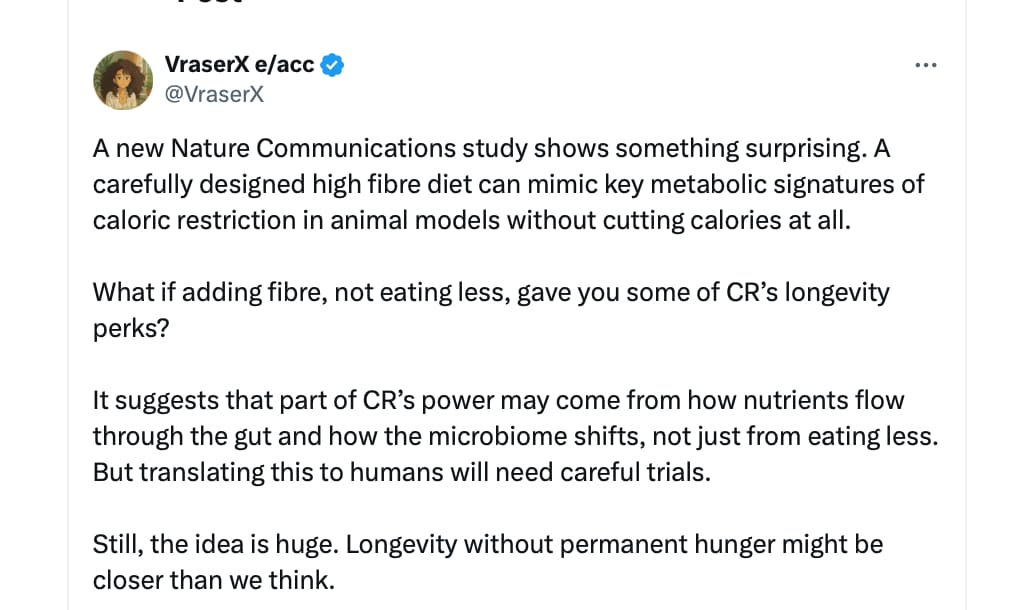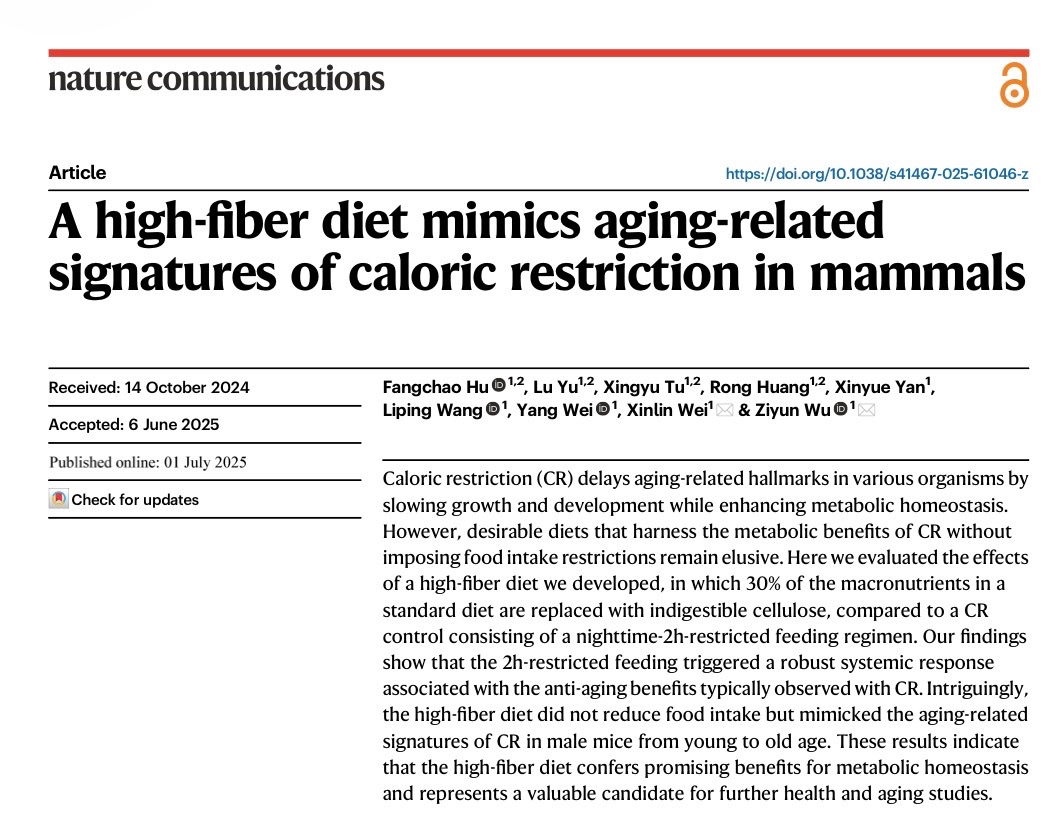Open access paper:
https://www.nature.com/articles/s41467-025-61046-z
Caloric restriction (CR), the reduction of food intake without malnutrition, has become a gold standard in anti-aging studies1. Despite the development and application of various CR-like protocols, such as ketogenic diets (KDs), intermittent fasting (IF), fasting-mimicking diets (FMDs), time-restricted feeding (TRF), protein restriction (PR), and methionine restriction (MR), many of these approaches involve excessive fasting and may lead to impaired growth, development, and other adverse effects2,3. A desirable caloric restriction mimetic (CRM) should emulate the growth and development seen with ad libitum feeding, while reproducing the metabolic, hormonal, and physiological benefits of CR without the drawbacks of excessive fasting and other undesirable side effects4,5. Additionally, a CRM should improve aging-related hallmarks, confer protection against a variety of stressors, and produce CR-like effects on aging and age-related diseases6.
Unfortunately, discovering an ideal CRM remains a formidable challenge2,3,6,7. Rapamycin, a Food and Drug Administration (FDA)-approved natural compound, has been proposed as a preeminent CRM candidate. It robustly extends lifespan robustly in many model organisms, including various mice models, even when initiated in 20-month-old wild-type mice8. However, despite the considerable attention that rapamycin and other mechanistic target of rapamycin complex 1 (mTORC1) inhibitors have garnered in the anti-aging community, their potential side effects, such as immunosuppression, hyperlipidemia, and hyperglycemia, must be carefully evaluated in clinical trials9,10. On the other hand, accumulating evidence suggest that the type and ratio of macronutrients in the diet, including carbohydrates, fats and proteins, exert a profound effect on growth, metabolism and longevity in model organisms, ranging from yeast to mice2,11,12. Moreover, some of these anti-aging dietary interventions do not necessarily involve reducing calorie or overall food consumption. Thus, it is conceivable that a desirable dietary CRM with fewer safety-related concerns commonly associated with drug development could be developed. However, it is worth noting that very few non-CR diet related longevity studies have included a classic CR as a positive control to parallelly evaluate CR-like benefits on growth, development, metabolism, and longevity3.
The key actionable insights from this paper:
Here are the key actionable insights from the paper “A high-fiber diet mimics aging-related signatures of caloric restriction in mammals” (Hu et al., 2025) published in Nature Communications. Given your interest in longevity and biomarker / dietary interventions, I’ll highlight what’s translational (yet still preliminary) and note caveats.
 What the study found
What the study found
- The authors developed a modified diet in male C57BL/6J mice in which ~30% of the standard macronutrients were replaced with indigestible cellulose fibre (the “CF30m” diet) while keeping vitamins/minerals constant.
- This fibre-rich diet did not reduce food intake in young mice, unlike classic caloric restriction (CR) regimens, yet it produced molecular signatures (transcriptomic + metabolomic) in liver that resemble those seen under CR.
- At the transcriptome level, the CF30m diet:
- Up-regulated genes associated with lipid/carbohydrate/cholesterol metabolism, cytoprotective pathways (e.g., autophagy) and extracellular matrix/collagen.
- Down-regulated genes linked to growth/translation, mitochondrial ATP synthesis, ribosomal biogenesis, immune/inflammatory signalling and response.
- At the metabolome level, CF30m increased many lipid and lipid-like metabolites (fatty acyls, glycerophospholipids, prenol lipids) more strongly than CR did, and reduced certain metabolites associated with aging or cellular damage (e.g., galactitol, indoleacetic acid).
- In middle-aged mice (starting at 6 months old, for 4 months of intervention) the CF30m diet improved:
- Glucose metabolism (oral glucose tolerance improved).
- Motor function (grip strength, rotarod) and cognitive performance (Morris water maze) compared to control diet.
- Skin/sub-dermal morphology — sub-dermal thickness reduced, closer to younger mice.
- In aged mice (~18 months old) the CF30m diet for 4 weeks also produced improvements: reduced body fat, improved lean mass, better glucose control, better motor and cognitive function compared to regular diet, and similar to CR.
- Mechanistically: they measured short-chain fatty acids (SCFAs) from fiber fermentation and ketone bodies (common CR mediators) and found minimal changes, suggesting neither SCFAs nor ketones are likely the primary mediators of the effect in this model.
 What this suggests for translation / longevity strategy
What this suggests for translation / longevity strategy
Given the mouse-model nature of the data, you should treat these as hypothesis generating, but here are actionable take-aways for someone looking at longevity/health optimisation:
- Incorporating a high-indigestible‐fibre diet (or substituting part of digestible macronutrients with a non-digested fibre) might mimic some of the beneficial molecular/physiological effects of caloric restriction without reducing overall caloric intake or causing weight loss.
- Because the diet did not require a reduction in food intake (in the young-mouse model) and yet produced CR-like signatures, it suggests a possible strategy of “nutrient dilution” (i.e., replacing some calories with fibre) as a feasible CR-mimetic strategy.
- Improvements in metabolic health (glucose tolerance, fat/lean mass ratio) + functional measures (motor, cognition) in middle-aged and aged mice suggest that fibre-based nutrient substitution even later in life may provide benefit.
- The large effect on lipid metabolism, collagen/extracellular matrix genes, and immune/inflammatory gene suppression suggests that targeting these pathways (via diet) is promising for longevity interventions: e.g., improving metabolic flexibility, reducing chronic inflammation, preserving tissue/collagen integrity.
- Because the SCFAs/ketones were not amplified, the mechanism may be independent of classic “fasting/ketosis” pathways; this opens the door to alternative dietary interventions beyond fasting/IF for longevity.
 Key caveats and limitations
Key caveats and limitations
- The model is male mice only (C57BL/6 J). No data yet on females or other species. The applicability to humans is very tentative.
- The substitution was with cellulose (an indigestible fiber in the diet), not a simple “more fibre” increment. The magnitude was ~30% of macronutrients, which is a large shift and may be difficult to replicate in human diets without side-effects (satiety, nutrient dilution, micronutrient deficits).
- Although they observed CR-like molecular signatures and physiological markers, lifespan extension data is not provided in this study (for this dietary intervention) — so we don’t yet know if this fibre intervention extends life.
- Timing and circadian alignment matter: their CR protocol was a nighttime 2h feeding in mice (to align with mouse active phase), and the high-fibre effect may depend on timing. Whether this translates to humans (diurnal species) is unclear.
- The mechanism remains unclear — although they ruled out major changes in SCFAs and ketone bodies, they did not identify definitive causal mediators (need further mechanistic studies).
- Because the study uses controlled diets in mice, real-world human dietary complexity (compliance, variation in fiber types, microbiome heterogeneity) could reduce effect size.
 Practical implementation ideas for a longevity-focused human protocol
Practical implementation ideas for a longevity-focused human protocol
Given your domain (biotech/health/longevity), you may want to consider how this might inform your personal dashboard or protocol design. Here are ideas:
- Target a moderate substitution of digestible macronutrients with indigestible (or low-digestibility) fibre — while keeping micronutrient intake adequate. For example, replacing part of starch or other high-glycaemic carbohydrates with non-digestible fibre sources (e.g., cellulose, certain resistant starches, non-fermentable fibres) and monitor for satiety, caloric intake changes, body composition, glucose tolerance.
- Monitor biomarkers relevant to the pathways affected — e.g., lipid metabolism profiles (glycerophospholipids, fatty acyls), markers of inflammation/immune activation (CRP, IL-6, TNF-α, maybe gene expression profiles if available), collagen/extracellular matrix turnover (PICP, Procollagen type I C-peptide perhaps), glucose tolerance/insulin sensitivity.
- Use functional tests as well as biochemical markers — e.g., grip strength/ physical function, cognitive screening, body composition (fat vs lean mass).
- Consider timing alignment with circadian rhythms: in humans, aligning feeding windows with active phase may enhance effects (analogous to the mouse nighttime feeding).
- Because the mechanism remains unclear, consider this approach as part of a multi-modal strategy (e.g., combine with protein/amino acid modulation, micronutrient optimisation, exercise).
- For your research library: note that the specific fiber type (cellulose) and the degree (~30% macronutrient substitution) were critical in the effect; simple “more fibre” may not suffice. For translation, you might track human studies using high levels of indigestible fibre or “nutrient dilution” diets.
If you like, I can extract and tabulate all the major gene-sets / metabolite-changes from the supplement (for your internal dashboard), plus estimate what an equivalent human diet intervention might look like (with macro/fibre substitution, satiety/energy intake projections, possible micronutrient risks). Would that be useful?
Implementation guidelines (for an experiment, not standard recommendation)
• Start by increasing insoluble, non‐fermentable fibre in meals (vegetable skins, whole grain bran, purified cellulose powder) but do so gradually (over weeks) to avoid GI distress.
• Replace part of your starch/carb load with fibre: e.g., substitute refined grains with high-bran whole grains + extra vegetable fibre, or incorporate a measured dose of purified cellulose as a bulking agent (with physician/nutrition oversight).
• Monitor biomarkers of interest: glucose tolerance (OGTT/HbA1c), body composition (lean vs fat mass), inflammation (CRP, IL-6), lipid metabolism (TG, LDL, HDL), perhaps gene expression or metabolomic if you have access.
• Hydration is key: high fibre needs sufficient fluid. Failure to hydrate may lead to obstruction or constipation. 
• Watch micronutrient absorption: Very high fibre diets may reduce absorption of iron, calcium, magnesium, zinc (especially bran/insoluble fibre containing phytates) unless diet is well-balanced. 
• GI health context matters: Individuals with IBS, IBD, GI surgery may tolerate high insoluble fibre poorly. 
“Department of Food Science and Engineering, School of Agriculture and Biology, Shanghai Jiao Tong University, Shanghai, China”
Not exactly first tier.
Perhaps, but…
Journal & Publication Quality
2.1 Peer-review and Indexing
- Journal: Nature Communications (Nature Portfolio).
- Peer-reviewed, open-access, multidisciplinary natural sciences journal.
- Indexed in Science Citation Index Expanded, MEDLINE/PubMed, Scopus , and other major databases.
2.2 Impact and Reputation
- 2024 Journal Impact Factor: 15.7; 5-year JIF: 17.2; SJR: 4.761; high citation influence and Q1 ranking in multidisciplinary sciences.
- Overall: high-prestige, mainstream outlet for solid mechanistic and translational biology.
Verdict: Journal quality is high; publication venue is a positive signal for methodological and editorial rigor.
We redesigned the standard AIN-93G diet to obtain four different diets by replacing either corn starch or the entire macronutrients with the two selected fibers, thus the total fiber (including the original 5% cellulose) in the eight high-fiber diets range from 15% to 35% (Supplementary Fig. 1a).
Cellulose at 5% of 2000 calories is 100 calories. Cellulose equivalent is leafy greens. 100 grams of spinach has 23 calories. So you need half a kilo (500 grams) of spinach, or other leafy greens per day.
A cup of spinach has 7 calories. 100 divided by 7 yields 14 cups of spinach per day.
As an aside 500 gm of spinach would carry a high oxalate load ( almost 4 gm) even if you have no concerns about kidney health or kidney stones or even liver.
A very high fiber diet intuitively makes total sense in the context of this publication. I aim for 30 gm / day but I struggle to get to that goal specially since I do time restricted eating. I have intermittently done cellulose etc. But IMO of all the dietary fads like keto, paleo, carnivore, Atkins, South Beach etc, HIGH FIBER earns the consistent TOP SPOT across the entire spectrum of health benefits (favorable CV/ lipid/ Glycemic benefits , weighloss, cancer protection and now supposedly Geroprotective). Of course, its effects on gut microbiome is the underlying denominator here. That is the key take away specially when we are indundated with ultraprocessed food in the grocery aisles and in our pantries.
No, but Nature Communications is a good, very strict, journal. I’ve been rejected from there plenty of times, hehe, and also had a couple successes, and reviewed manuscripts for them. You can also see that the paper was submitted in October 2024 and accepted in June 2025, so the authors likely had a lot of changes to make to the manuscript.
I would also guess that they tried Nature Aging, were rejected for lack of lifespan data, and used the transfer system to carry across to Nature Communications. That’s quite a common path.
But anyway, 30% of my diet being cellulose sounds absolutely horrible. Wonder if I’d ever be able to leave the bathroom haha.
From what I’ve read and also experienced, cellulose seems to mostly exit as Bristol-4 perfection poops— only some becomes SCFAs. Acarbose flips it: colon carbs get fully fermented, big SCFA output, minimal stool sculpting. Same pathway as fiber, just far more biome-feeding (and the gas to prove it)


